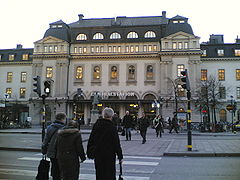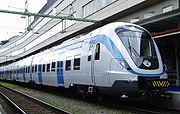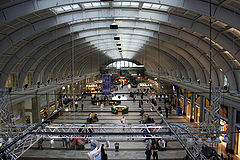
Stockholm Central Station
Encyclopedia
Stockholm Central Station is the largest railway station in Sweden
. The station is situated in the district of Norrmalm at Vasagatan
/Central Plan. Opened July 18, 1871, the station is the largest in Sweden, with over 200,000 visitors daily. Of them are about 170,000 travellers (105,000 with commuter trains, 25,000 with Arlanda Express and 40,000 with other trains).
In front of the central station stands a statue of Nils Ericson
.
 The station was built between 1867 and 1871 with Adolf W. Edelsvärd
The station was built between 1867 and 1871 with Adolf W. Edelsvärd
as the architect. Until 1925 the tracks led in to the station but during a renovation 1925-1927 the tracks were moved to the west and the former track hall was converted into a 119 meter long, 28 meter wide and 13 meter high waiting hall. During the renovation the station was extended to the south through the construction of the southern pavilion. Today this part of the station houses a conference facility. Next to the conference facility is the Royal waiting hall where the Royal Family waits when travelling by train.
In 1951 the façade towards Vasagatan was changed and given a more simplified look. In 1958 an underground passage to T-Centralen
was opened.
 The station consists of two parts:
The station consists of two parts:
On level with the Northern Railway Square are service depots for long-distance and regional trains. Trains arriving from the south and turning back from the central station, after passengers continuing northwards have disembarked, continue to the service depots where they are cleaned and have their supplies refilled. Then they continue back via tracks 10 to 12. Long-distance trains from tracks 4 to 8 are services in the same way near the Northern Railway Square.
, with about 53 thousand people boarding the trains and about as many disembarking every weekday (as of 2005). The commuter rail uses two platforms and tracks 13 to 16. Each platform has entries with entry gates from the lower level and a ticket sales office on the upper level with an entry from Klarabergsviadukten
.
The commuter trains go on their own tracks along Ostkustbanan via Tomteboda
, and after Karlberg Station they go underneath the other tracks to avoid conflict with long-distance and regional trains. After the centre, they join the Stockholm connection railway to the south, which has had two tracks since 1871. In 2006, a decision was finally made to construct Citybanan
, a new track in a tunnel, and Stockholm City Station
, a new station for commuter trains below T-Centralen
. The construction was started in January 2009 and will probably be finished in 2017.


Sweden
Sweden , officially the Kingdom of Sweden , is a Nordic country on the Scandinavian Peninsula in Northern Europe. Sweden borders with Norway and Finland and is connected to Denmark by a bridge-tunnel across the Öresund....
. The station is situated in the district of Norrmalm at Vasagatan
Vasagatan, Stockholm
Vasagatan is a major street in central Stockholm named after King Gustav Vasa.In its southern end it is connected to the old town Gamla Stan by the bridge Vasabron, from where it stretches north to the public square Norra Bantorget. It passes in front of the Stockholm Central Station and is...
/Central Plan. Opened July 18, 1871, the station is the largest in Sweden, with over 200,000 visitors daily. Of them are about 170,000 travellers (105,000 with commuter trains, 25,000 with Arlanda Express and 40,000 with other trains).
In front of the central station stands a statue of Nils Ericson
Nils Ericson
Friherre Nils Ericson was a Swedish mechanical engineer...
.
History

Adolf W. Edelsvärd
-Further reading:...
as the architect. Until 1925 the tracks led in to the station but during a renovation 1925-1927 the tracks were moved to the west and the former track hall was converted into a 119 meter long, 28 meter wide and 13 meter high waiting hall. During the renovation the station was extended to the south through the construction of the southern pavilion. Today this part of the station houses a conference facility. Next to the conference facility is the Royal waiting hall where the Royal Family waits when travelling by train.
In 1951 the façade towards Vasagatan was changed and given a more simplified look. In 1958 an underground passage to T-Centralen
T-Centralen
T-Centralen is a metro station that forms the heart of the Stockholm Metro system, in the sense that it is the only station where all three of the system's lines meet...
was opened.
Traffic

- The northern part, with tracks 1 to 7 northwards, constitutes a terminus station for the OstkustbananOstkustbananThe East Coast Line is a long mainline railway in Sweden, linking the cities of Stockholm, Uppsala, Gävle and Sundsvall, as well as the suburbs north of Stockholm.-Electrification:...
, MälarbananMälarbananThe Mälaren Line is a railway line from Stockholm via Västerås to Örebro in Sweden. The section from Stockholm to Kolbäck and from Valskog to Arboga has double track. The line was upgraded to high-speed in 2005. The line is mostly used by passenger trains, although it is also served by some...
and ArlandabananArlandabananThe Arlanda Line is a long railway line which allows trains on the East Coast Line to reach Stockholm-Arlanda Airport in Sigtuna Municipality, Sweden. The Arlanda Line branches from the East Coast Line at Rosersberg and rejoins again at Myrbacken. It is built for speeds of , is electrified at ...
railways. Tracks 1 to 2 are reserved for the Arlanda Express, which has its own platform on the same level as the trains' floor. Track 3 is mostly used by Uppsalapendeln and tracks 4 to 7 are used for long-distance and regional traffic and overnight traffic to the north. - Tracks 10 to 19 in the western part constitute a passing station for Västra stambananVästra stambananThe Western Main Line is the main railway line between Stockholm and Gothenburg in Sweden. The line is electrified and consists entirely of double track, except the four-track sections between Gothenburg Central Station and Olskroken , in Järna Station , and south of Stockholm, between...
and local commuter trains. Tracks 10 to 12 are mostly used for long-distance and regional trains to the south, but can also be used for traffic to the north, while tracks 17 to 19 are mostly used for long-distance and regional trains to the north, but can also be used for traffic to the south. Most of the trains turn back after the Stockholm Central Station, but some trains continue towards the north.
On level with the Northern Railway Square are service depots for long-distance and regional trains. Trains arriving from the south and turning back from the central station, after passengers continuing northwards have disembarked, continue to the service depots where they are cleaned and have their supplies refilled. Then they continue back via tracks 10 to 12. Long-distance trains from tracks 4 to 8 are services in the same way near the Northern Railway Square.
Commuter train station
The Stockholm Central station is the busiest station on the Stockholm commuter railStockholm commuter rail
Stockholm Commuter Rail is the commuter rail system in Stockholm County, Sweden. The system is an important part of the public transport in Stockholm, and is controlled by Stockholm Transport; the trains are operated under contract by Stockholmståg...
, with about 53 thousand people boarding the trains and about as many disembarking every weekday (as of 2005). The commuter rail uses two platforms and tracks 13 to 16. Each platform has entries with entry gates from the lower level and a ticket sales office on the upper level with an entry from Klarabergsviadukten
Klarabergsviadukten
Klarabergsviadukten is a reinforced concrete bridge and a viaduct in central Stockholm, Sweden. Stretching over Klara Sjö, it connects Norrmalm to Kungsholmen....
.
The commuter trains go on their own tracks along Ostkustbanan via Tomteboda
Tomteboda
Tomteboda is a place in northern Stockholm, Sweden known for its post terminal and its shunting yard. A new railway tunnel for commuters is planned between Stockholms södra station and Tomteboda.- External links :...
, and after Karlberg Station they go underneath the other tracks to avoid conflict with long-distance and regional trains. After the centre, they join the Stockholm connection railway to the south, which has had two tracks since 1871. In 2006, a decision was finally made to construct Citybanan
Citybanan
The Stockholm City Line is a railway tunnel under construction beneath central Stockholm in Sweden which will be used by the Stockholm Commuter Rail. The line will be long, double track and electrified. It will have two stations: Stockholm City Station will be located directly below T-Centralen,...
, a new track in a tunnel, and Stockholm City Station
Stockholm City Station
Stockholm City Station is a railway station which is under construction in downtown Stockholm, Sweden. Scheduled to open in 2017, the station is located on the Stockholm City Line and will be located directly below T-Centralen, the central station of the Stockholm Metro, and with interchange with...
, a new station for commuter trains below T-Centralen
T-Centralen
T-Centralen is a metro station that forms the heart of the Stockholm Metro system, in the sense that it is the only station where all three of the system's lines meet...
. The construction was started in January 2009 and will probably be finished in 2017.
Services


- Arlanda ExpressArlanda ExpressArlanda Express is an airport rail link connecting Stockholm Central Station with Stockholm-Arlanda Airport outside Stockholm, Sweden. Operated by A-Train AB, the trip takes 20 minutes and runs four to six times per hour using seven X3 electric multiple units...
- Stockholm-Arlanda Airport
- SJSJ ABSJ is a government-owned passenger train operator in Sweden. SJ was created in 2000, out of the public transport division of Statens Järnvägar, when the former government agency was divided into six separate government-owned limited companies.-Overview:SJ's operations fall broadly into subsidised...
- Intercity servicesInter-city railInter-city rail services are express passenger train services that cover longer distances than commuter or regional trains.There is no precise definition of inter-city rail. Its meaning may vary from country to country...
- Falun via Uppsala, Avesta Krylbo, Borlänge
- Karlstad via Katrineholm, HallsbergHallsbergHallsberg is a bimunicipal locality and the seat of Hallsberg Municipality, Örebro County, Sweden with 7,122 inhabitants in 2005. It is also partly located in Kumla Municipality.-Overview:...
- Göteborg via Västerås, Örebro
- Oslo via Karlstad
- Mora via Uppsala, Avesta Krylbo, Borlänge
- Östersund via Uppsala, Gävle, Bräcke
- Sundsvall via Uppsala, Gävle
- Night trainSleeping carThe sleeping car or sleeper is a railway/railroad passenger car that can accommodate all its passengers in beds of one kind or another, primarily for the purpose of making nighttime travel more restful. The first such cars saw sporadic use on American railroads in the 1830s and could be configured...
- Luleå via Uppsala, Gävle, Sundsvall, Umeå
- Malmö via Gothenburg
- Narvik via Umeå, Boden, Gällivare, Kiruna
- Oslo via Karlstad
- Storlien via Uppsala, Gävle, Sundsvall, Östersund, Åre
- SJ commuter rail services
- Arboga via Södertälje Syd, Strängnäs, EskilstunaEskilstunaEskilstuna is a city and the seat of Eskilstuna Municipality, Södermanland County, Sweden with 60,185 inhabitants in 2005. Eskilstuna has a large Sweden Finn population....
- Hallsberg via Södertälje, Katrineholm
- Linköping via Södertälje, Nyköping, Kolmården, Norrköping
- Gävle via Uppsala, some service continues to Ljusdal
- Uppsala
- Västerås via Enköping,
- Hallsberg via Enköping, Västerås, Arboga, Örebro
- Arboga via Södertälje Syd, Strängnäs, Eskilstuna
- X 2000X 2000X 2000 is the brand name of Sweden's tilting 200 km/h high-speed train class X2, which was constructed by Kalmar Verkstad in Kalmar, Sweden and operated by SJ. It was launched in 1990 as a first-class only train with a meal included in the ticket price, and free use of the train's fax machine...
Express Intercity services- Åre via Uppsala, Sundsvall, Östersund
- Arvika via HallsbergHallsbergHallsberg is a bimunicipal locality and the seat of Hallsberg Municipality, Örebro County, Sweden with 7,122 inhabitants in 2005. It is also partly located in Kumla Municipality.-Overview:...
, Karlstad - Borås via Skövde, Herrljunga
- Jönköping via Linköping
- Malmö via Norrköping, Nässjö, Lund
- Copenhagen via Norrköping, Nässjö, Lund, Malmö
- Falun via Uppsala, Avesta Krylbo, Borlänge
- Göteborg via Katrineholm, Skövde
- Nässjö via Norrköping
- Sundsvall via Uppsala, Gävle
- Uddevalla via Skövde, Herrljunga (Seasonal continuation to Strömstad)
- Intercity services
- SLStorstockholms LokaltrafikStorstockholms Lokaltrafik AB, , commonly referred to as SL, is the organisation running all of the land based public transport systems in Stockholm County....
(operated by Stockholmståg)- Stockholm commuter railStockholm commuter railStockholm Commuter Rail is the commuter rail system in Stockholm County, Sweden. The system is an important part of the public transport in Stockholm, and is controlled by Stockholm Transport; the trains are operated under contract by Stockholmståg...
- Bålsta
- Märsta
- Nynäshamn
- Södertälje
- Stockholm commuter rail
- Veolia TransportVeolia TransportVeolia Transport is the international transport services division of the French-based multinational company Veolia Environnement...
- Night trainSleeping carThe sleeping car or sleeper is a railway/railroad passenger car that can accommodate all its passengers in beds of one kind or another, primarily for the purpose of making nighttime travel more restful. The first such cars saw sporadic use on American railroads in the 1830s and could be configured...
- Åre (Seasonal)
- Night train
- FlygbussarnaFlygbussarna-External links:*...
-
- Arlanda
- Bromma
- Skavsta
- Västerås
-

